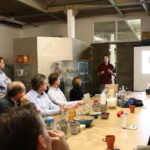
The Braindump
People rarely enter a brainstorm session (or any other thinking session) with an ‘empty’ mind. Most participants will start the session thinking about preferred approaches and directions. Anyone organising a thinking session should be wary of this.
“The problem is never how to get new, innovative thoughts into your mind, but how to get old ones out.” – Dee Hock
The people who participate in a brainstorm session will usually already have given the challenge at hand some thought. Before the session has even started, their head will be full of ideas. Great as this might sound, it can have disastrous implications.
The problem
If you fail to address the already existent ideas and beliefs, you will soon face the consequences. People will find ways to arrive at their pre-destined ideas, regardless the thinking techniques you use. This (sometimes unconscious) tendency toward a pre-determined direction is not the only drawback you’ll encounter. People are also far less open to other participants’ ideas when they are clinging to their own beliefs. After all, it’s hard to pay attention when you’re trying to remember the brilliant point you’d like to make.
Luckily all of this can easily be prevented. A so-called ‘Braindump’ at the beginning of your session will lead to a much more creative outcome. It’s an incredibly simple exercise that enables every participant to break free from their pre-existing ideas.
The Braindump
With a Braindump, participants basically empty their brains. During the Braindump, everyone writes down all the ideas they already have and everything else that immediately pops into their minds. Give the group 10 minutes to jot everything down. After 10 minutes, people will feel ‘empty’. They might even believe they’ve exhausted their ideation potential. Little do they know, this is only the beginning.
At the ten-minute-mark, discuss the ideas in the group. All ideas must be shared, but a debate has to be avoided. It’s great if new ideas or improvements are added to the ideas that are being shared, but criticising ideas is not allowed.
Once all ideas are shared (and briefly explained) it’s time to start the search for new, innovative ideas!
The result
The many ideas that people had at the start of the session are now written down on paper. Make sure people know this means these ideas will be part of the end result. When participants are confident their beloved ideas will be seriously considered in the evaluation phase, they are much more inclined to think about alternatives. Having ‘freed’ their minds, appropriate thinking techniques can now help them look for ideas in very different directions.
Conclusion:
Never start a thinking session without a Braindump. While the activity doesn’t seem spectacular, spending some minutes emptying participants’ brains will invariably save your thinking session.
After reading this, it won’t surprise you that every Brightstorming-session starts with a Braindump. During 10 minutes, all participants will (individually) write down the ideas that are already occupying their minds. After collecting existing (and likely obvious) ideas, it’s time for the real magic…
Curious how Brightstorming can help your team excel creatively? Shoot us an email at info@brightstorming.com and tell us a bit about your situation. We’d be more than happy to discuss the possibilities with you.
